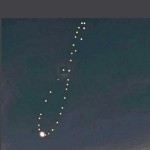 I’m in a new phase with deep winter: I now feel the ink-cold blackness at breakfast, the shutting down of the world in late afternoon.
I’m in a new phase with deep winter: I now feel the ink-cold blackness at breakfast, the shutting down of the world in late afternoon.
For days I’ve pondered the people whose pain comes from encroaching darkness, enough to make them stare into banks of artificial light – or take mood-shifting drugs – to keep from tipping over into nothingness. Or raging. Or both. Primordially, diurnal creatures could curl up during the dark times and sleep. Not now for us, with artificial schedules, timepieces, heaters, bulbs and screens glowing through the night, frenzies of all kinds. To catch the natural darkness underneath, I looked up black light, to see if the metaphor fit: yes, beyond physical vision, making things glow – like bits of sentience that fade when unlit by attention, when drowned out by fake tides of bright light. What glows in this black light of midwinter are the real feelings underneath the surface colors.
In previous winters, I’ve been barricaded against awareness of this enveloping cold blackness: first was the child’s hysteria about the coming of gifts and forbidden foods, the rare permissions of parties and strange relatives. Then came a wall of intellect, the study of Saturnesque and Mithraic celebrations, the clinical compulsions of psychology. Then came a different wall, an irritation at the mismatch among all my worlds, a determination to shield myself, even in seasonal rites, from the fractious chaos around me. And most recently, I’ve split from earthly scenes and reveled in wonderment at the starry heavens, at sensations of dislocation in a whirling cosmos.
Something has shifted. I’m able to shiver and marvel at the existential terror I imagine ancient peoples felt, when it seemed the sun was ending forever. Legends would be told or acted around the fire, surrounded by torchlight, but there may’ve been a gap, then as now, between what one receives second-hand and what one sees (or not) with one’s own eyes, what one’s body knows. I wondered if I might finally have arrived at a consciousness sturdy enough to open fully to the inevitability of its own physical demise. I learned thirty years ago that this is a fundamental step in the enlightenment process (irony intended).
To talk about darkness without mentioning the big sleep, I looked up local sunrise and sunset times for December 21 (the moment of solstice being 9:48 MT that night). Shock. If I’d ever known that sunrise and sunset times do *not* track calendar dates exactly, I’d forgotten it. I’ve had such a good time boggling over sunrise at seven fifteen and sunset at five fifteen, I unconsciously expected the trends to reverse exactly on the 21st. They don’t. Nature is more subtly complicated than our tick-tockers.
To re-ground into something more reliable, I kept going, eventually into the mystical alchemical analemma: a figure-8 year-long “constellation” of dozens of suns glowing in my mind’s midwinter black light, showing me pictorially the relationship between clock time and the sun’s appearances in a year. I got enchanted by the ways people calculate our place in the moving universe, thinking to map the shifting heavens, rarely fully understanding the depth to which we’re tracking our own interactive, relative journey. And I was comforted by the analemma’s vision of continuity, our hyper-dark moment a blip on the track of infinity.
So then, with so much more context, I could relax into Time. From this vulnerable space, I have a richer empathy with those who wish to avoid feeling it. Tenderness springs up for us all.